Mycenaean Art › Brundisium » Ancient origins
Articles and Definitions › Contents
- Mycenaean Art › Antique Origins
- Brundisium › Ancient History
Ancient civilizations › Historical and archaeological sites
Mycenaean Art › Antique Origins
Definition and Origins
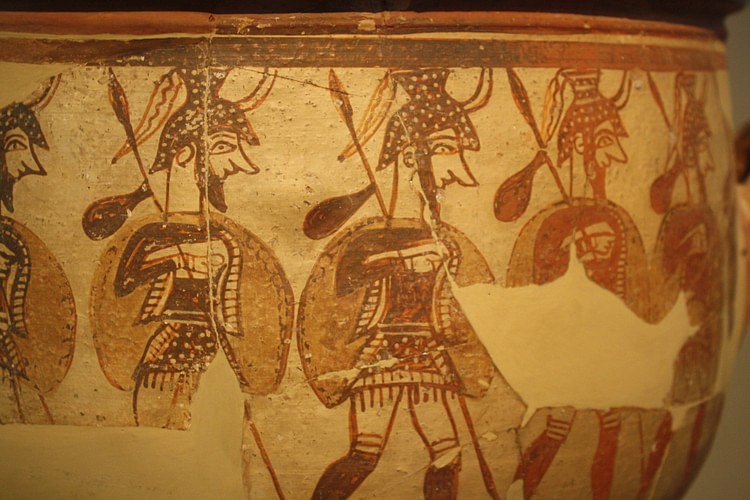
The Mycenaean civilization flourished in the late Bronze Age from the 15th to the 13th century BCE, and their artists would continue the traditions passed on to them from Minoan Crete. Pottery, frescoes, and goldwork skillfully depicted scenes from nature, religion, hunting, and war. Developing new forms and styles, Mycenaean art would prove to be more ambitious in scale and range of materials than Cretan art and, with its progression towards more and more abstract imagery, go on to influence later Greek art in the Archaic and Classical periods.
INSPIRATIONS
The Mycenaean civilization was based on mainland Greece but ideas and materials came via trading contacts with other cultures across the Mediterranean. Imported materials included gold, ivory (principally from the Syrian elephant), copper, and glass, while in the other direction went Mycenaean goods such as pottery to places as far afield as Egypt, Mesopotamia, the Levant, Anatolia, Sicily, and Cyprus.
In art as expressed in fresco, pottery, and jewellery, the earlier Minoan culture on Crete greatly influenced Mycenaean art.The Minoan love of natural forms and flowing design especially was adopted by Mycenaean artisans but with a tendency to more schematic and less life-like representation. This new style would become the dominant one throughout the Mediterranean. Geometric designs were popular, too, as were decorative motifs such as spirals and rosettes. Pottery shapes are much like the Minoan with the notable additions of the goblet and the alabastron (squat jar) with a definite preference for large jars. Terracotta figurines of animals and especially standing female figures were popular, as were small sculptures in ivory, carved stone vessels, and intricate gold jewellery. Frescoes depicted plants, griffins, lions, bull-leaping, battle scenes, warriors, chariots, figure-of-eight shields, and boar hunts, a particularly popular Mycenaean activity.
MYCENAEAN ARTISANS DISPLAYED A TENDENCY TO MORE SCHEMATIC & LESS LIFE-LIKE REPRESENTATION THAN SEEN IN MINOAN ART.
MYCENAEAN POTTERY
Early wheel-made Mycenaean pottery from mainland Greece has been described as 'provincial Cretan' which does convey the fact that although shapes and decorative styles were of Cretan origin, the final decoration was not quite as finely executed as in Minoan centres such as Knossos and Phaistos. Mycenaean clay was often superior in quality to Minoan, though, and was fired at higher temperatures. Some clay vessels were tin-plated too, perhaps to imitate more costly silver and bronze wares.
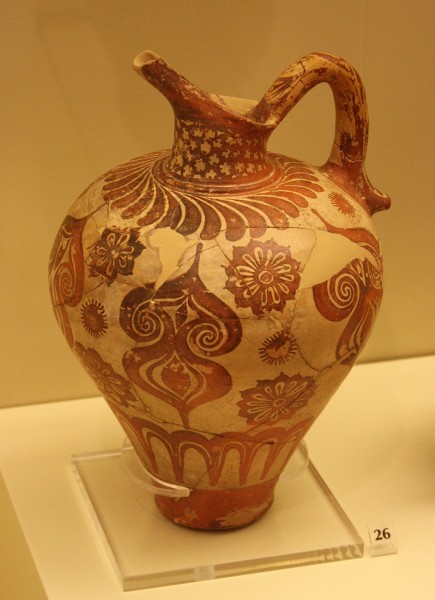
Mycenaean Jug
Popular Mycenaean vessel forms include stemmed cups, one-handled teacups, tankards and jugs with vertical strap handles and either spouts or cut-away necks. The most popular form was the stirrup jar, so called because the handle resembles a double stirrup. The centre of the handle was often decorated to look like a spout whereas the true spout was in fact to the side and separate from the handle. The second most popular vessel shape was the alabastron, a squat jar of various sizes, so named because the early examples were made from alabaster.
Clay sarcophagi had been widely used by the Minoans to bury their dead, and they usually took the form of either a chest with short legs or a bathtub. They were decorated in much the same manner as pottery vessels. Mycenaean Crete continued to produce them in great numbers. Clay was also used to make rhyta - vessels used for pouring libations and ceremonial drinking during religious ceremonies. These are most commonly in a conical form and are decorated as contemporary pottery vessels.
Like the Minoans, the Mycenaeans loved to paint sea life, especially octopuses and nautiluses. Designs also continued to fill all of the decorative surface and follow the contours of the vessel. Mycenaean pictorial scenes include chariots and human figures, something extremely rare in Minoan pottery. Sacral knots, double axes, and tusked helmets were popular subjects as were animals, birds, and griffins, often arranged heraldically and themselves decorated with pattern designs, possibly imitating contemporary textile designs. An excellent example of this technique can be seen in the bull and bird decorated vase from the British Museum, where the bodies are divided into sections, each decorated differently with dots, wavy lines, scales, crosses, or chevrons.
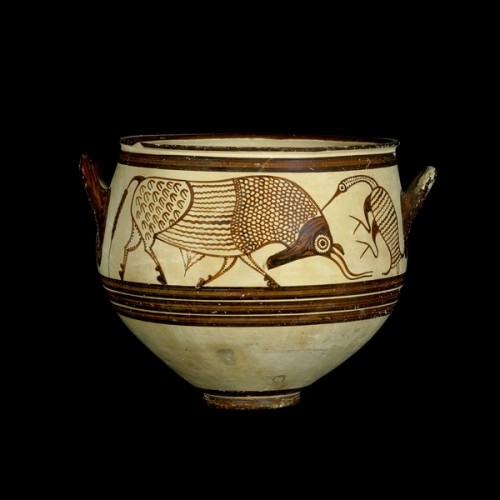
Mycenaean Vase Decorated With Bulls & Birds
Gradually, representations became more stylistic and more symmetrical with not all of the decorative space filled, leaving significant blanks, again, something rarely seen in Minoan pottery. Depictions of plants such as lilies, palms and ivy became more monumental, evolving into commonly employed motifs that were reserved principally for large jars. Designs on pottery eventually became so abstract that the original subject becomes almost unrecognisable. Another development is a preference for only a single motif design on each side of the vessel and a marked increase in the space left blank. An excellent example is the Ephyrean goblet, a stemmed, two-handled cup from Mycenae, which is decorated with a single large rosette on each face.
The pottery of the Mycenaean civilization, then, achieved its own distinctive decorative style which was strikingly homogeneous across Mycenaean Greece. The Mycenaean fondness for stylized and minimalistic linear designs would go on to influence the early pottery of Archaic and Classical Greece from the 9th century BCE.
MYCENAEAN FRESCOES
Mycenaean frescos which decorated palace walls and other buildings were similar to those of Minoan Crete, with nature and marine life again being the subject of choice. Mycenaean artists, as with potters, favoured a more monumental effect and a greater preference for depicting religious ceremonies, processions, hunters and warriors. Unfortunately, examples of Mycenaean frescoes only survive in fragments. Those from Mycenae include a female figure in profile wearing a tight-fitting jacket and holding perhaps a necklace which is similar to the one she is wearing. A fragmentary fresco with a very similar subject was discovered at Tiryns. Another surviving example from Mycenae is the fresco of the figure-of-eight shields, which has shields which appear to be made of cow skin.
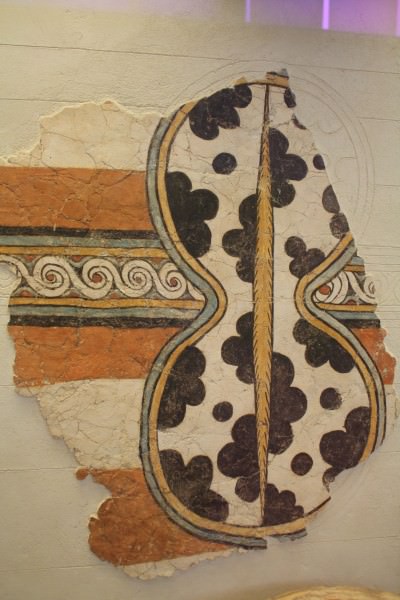
Mycenaean Shield Fresco
MYCENAEAN SCULPTURE
Clay figurines have been found at sites across the Mycenaean empire, dating from the 14th to 12th centuries BCE and remarkably similar in design. Highly stylized to the point of being almost unrecognisable as human forms, the figures are most commonly female and standing, probably representing a nature goddess. Often these figures have two arms raised or crossed in front of the chest, a long skirt, and a conical headdress. They are simply decorated with bold lines and sometimes jewellery is also painted on the figure using simple dots. From 1200 BCE clay animal figures, especially bovids, were also popular.Made on the wheel and with limbs and heads made by hand, they are likewise simply decorated with lines and dots. Figurines were also carved from bone and probably wood (which has not survived).
IVORY BOXES & PANELS TO ATTACH TO FURNITURE ARE MORE NUMEROUS & THESE OFTEN CARRY REPRESENTATIONS OF SPHINXES.
A head of possibly a sphinx in plaster with painted features is something of an enigma but, nevertheless, is firm evidence that Mycenaean artists were interested in sculpture even if few examples survive. It dates to the 13th century BCE and was discovered at Mycenae. Ivory figures are rare but an outstanding piece is the two goddesses and child figure group from Mycenae. Ivory boxes and panels to attach to furniture are more numerous, and these often carry representations of sphinxes.Several limestone tomb markers have been excavated, and these are carved with relief designs typical of those found in other art works. One of the largest scale pieces of Mycenaean sculpture is the famous lion gate of Mycenae. Carved from limestone the pair of lions sit either side of a column and date to c. 1250 BCE. They are an excellent example of a common feature of Mycenaean art: a Minoan subject (in this case one seen in their seals) that is realised on a scale and in a form entirely Mycenaean.
Finally, and amongst the most impressive of all Mycenaean art works, there are the gold rhytons and death masks. One of the finest examples of the former is that in the form of a lion's head now in the National Archaeological Museum of Athens. The death masks were placed over the face of the deceased, and although not exactly portraits, they are each different. The most famous is undoubtedly the so-called 'Death Mask of Agamemnon ' although, dating to the mid-16th century BCE, it is four centuries too early to be in the same time frame as Homer ’s king of Mycenae.
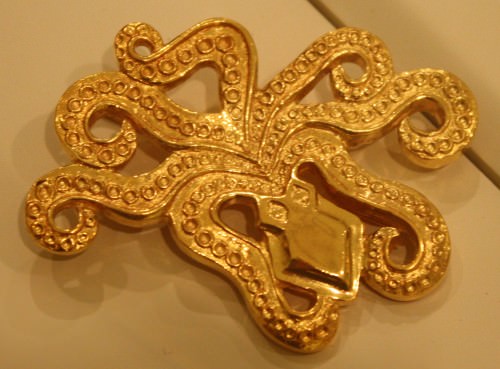
Mycenaean Octopus Brooch
MYCENAEAN JEWELLERY
Mycenaean jewellers used gold, glass, faience, precious and semi-precious stones (eg carnelian, agate, and rock crystal), and amber to produce necklaces, pendants, rings, earrings, pins, brooches, and diadems. The full range of metalworking techniques was employed and even enamelling which the Minoans had not mastered. Glass beads were shaped, carved, and made from moulds.
Like the Minoans before them, Mycenaean artists became expert engravers and created miniature masterpieces on rings and seals. Early examples follow Minoan traditions of religious scenes and mythological creatures or hunting animals. Later examples show the stylized flowers and plants seen in pottery decoration, and the form is different, small squares of gold being typical. One of the finest rings is from Tiryns and shows a seated goddess being approached by a procession of four demon-like creatures bearing offerings.
Another medium for the engraver's art was the bronze blades of swords and daggers which show scenes of mythology and hunting rendered in inlaid gold and silver. Finally, fine gold work is exquisitely represented in several surviving gold cups. The finest are two examples from Vapheio, decorated with embossed scenes of men attempting to capture bulls. Both are in the National Archaeological Museum in Athens.
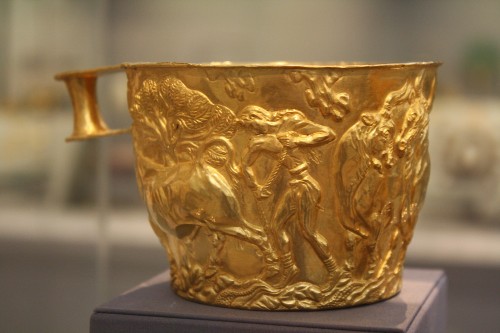
Vapheio Cup
LEGACY
Mycenaean artistic influence is perhaps most tangible in its pottery which was exported and imitated not only throughout the Aegean but also in places as far afield as Anatolia, Syria, Egypt, and Spain. There is also evidence that Mycenaean potters actually relocated and set up workshops abroad, particularly in Anatolia and southern Italy. Indeed, it may well be that designs of a Mycenaean origin introduced into these areas lived on to be reintroduced back to mainland Greece once the so-called Dark Ages had ended. The geometric pottery of the 8th century BCE certainly owed a great debt to the highly stylized pottery decoration so loved by the Mycenaeans. This, then, is perhaps the greatest contribution the Mycenaeans made to Western art: they carried the torch of artistic endeavour, passing it from the Minoans to Archaic Greece and so perpetuated the traditions which distinguished European art from the East.
Brundisium › Ancient History
Definition and Origins
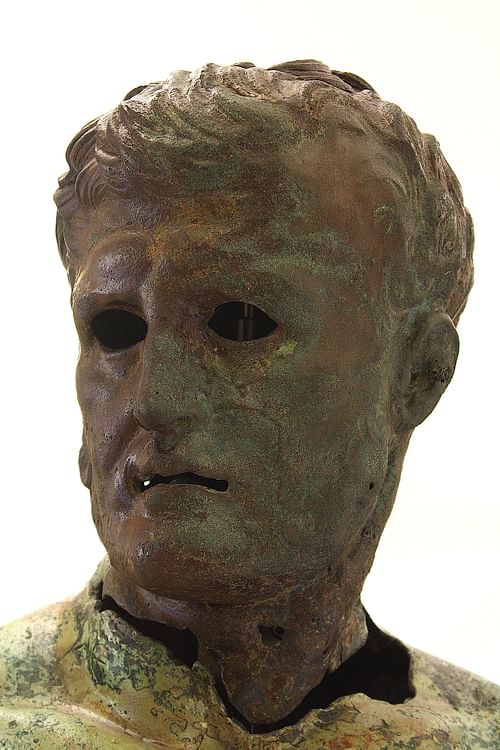
Brundisium (modern Brindisi), located on the Adriatic coast of southern Italy, was a Messapian and then Roman town of great strategic importance throughout antiquity. Although architectural remains are sparse, the city has several claims to fame.Brundisium is the end of the road for the Appian Way, was a traditional launching point for armies and travellers to the East, and played a pivotal role in both the Punic wars and Roman civil wars. Amongst its more impressive artefacts are many examples of Hellenistic and Roman bronze statuary which have been rescued from the town's harbour.
EARLY SETTLEMENT
The area of Brindisi was inhabited in Palaeolithic times some 12,000 years ago and the site of Torre Testa just 7 km to the north was the most important settlement in the region at that time. Thousands of stone tools and other artefacts have been discovered which belonged to the hunter-gatherers of the period. A continued presence in the Neolithic period and Bronze Age is attested by additional finds.
MESSAPIAN & GREEK TOWN
Located at the very bottom of the Italian peninsula, in local mythology Brundisium was first settled by either Diomedes, a hero of the Trojan War, or Phalanthus, the Spartan who was also credited with founding nearby Tarentum (modern Taranto). Yet other sources suggest Brundisium was founded by settlers from Crete. Certainly, a Greek influence, if not actually full colonization, is indicated in the cemetery at Tor Pisani. Little is known today regarding the town when it was inhabited by the Messapians, one of the tribes who lived in the 'heel' of Italy which constitutes modern Apulia. Their name for the town was Brentesion which may derive from the Messapian brentos, meaning 'dear's head', which describes the form of the harbour with its two distinctive promontories.
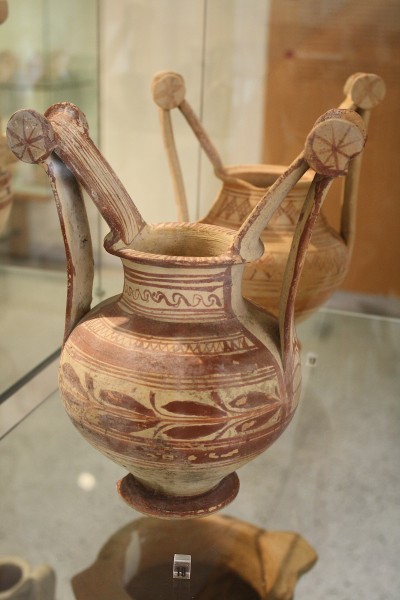
Two-handled Vase, Brundisium
The best surviving examples of Messapian culture are ceramics. In particular, the high-handled amphorae known as trozella are unique to the region and have geometrical and plant motif decorative designs. There is evidence of a long and bitter rivalry with Tarentum (modern Taranto), the Spartan colony some 75 kilometres to the west on Italy's southern coast. Brundusium minted its own coinage and formed an alliance with Thurii c. 440 BCE, another Greek colony to the west built on the site of old Sybaris.
ROMAN BRUNDISIUM
Brundisium started to take on a greater regional significance only from the 3rd century BCE onwards when Rome began to expand throughout the Italian peninsula. The Romans conquered the city in 266 BCE and a colony was formally established at Brundisium in 247 or 244 BCE. The city was then fortified in order to ensure the Romans kept hold of the excellent double harbour they had acquired. Around the same time the great Roman road the Via Appia (Appian Way) was extended to reach the city, connecting it with Rome itself and bringing its total paved length to 569 km or 385 Roman miles. Brundisium consequently became the main point of departure for anyone travelling to Greece and the East and usurped Tarentum's position as the most important port in the south. Today a 19.2 m tall single marble column stands near the waterfront which was traditionally thought to mark the spot where the road finally ends. In fact, inscriptions reveal that the column once belonged to a building with a religious or commemorative function connected to the sea.

End of the Appian Way Column Marker
During the First Punic War (264-241 BCE) the Carthaginian general Hamilcar Barca had attacked several Roman coastal cities in search of booty for his mercenaries and one of them was Brundisium in 247 BCE. These skirmishes, though, were largely a minor distraction from the main battlefront in Sicily. The city became more directly embroiled in the Second Punic War (218-201 BCE) when Hannibal invaded Italy and encamped in the southern corner of the peninsula. The Carthaginian general desperately needed a port through which he could receive reinforcements and supplies from Africa but the Romans successfully blockaded the harbours of the southern coast.
IN THE CIVIL WAR OF THE 1ST CENTURY BCE BRUNDISIUM WOULD, ONCE AGAIN, FIND ITSELF CENTRE STAGE IN THE THEATRE OF A BLOODY & BRUTAL WAR.
Sulla gave Brundusium an exemption from the portoria, the tax duty imposed on the import and export of goods at ports, and the town was given municipium status around 89 BCE which granted its citizens Roman citizenship. However, the city's fortunes would soon suffer a dramatic downturn during the violent final stages of the Roman Republic. In the civil war of the 1st century BCE Brundisium would, once again, find itself centre stage in the theatre of a bloody and brutal war. Julius Caesarcaptured the city in 49 BCE so that he could prevent his great rival Pompey from fleeing Italy. Then it was attacked again in 40 BCE, this time by Mark Antony. The city's handy location at the foot of Italy was proving something of a liability for the local residents. Brundisium was also the site of the accord, known as the Treaty of Brundisium, between Antony and Octavian to carve up the Roman empire between themselves. When Octavian won the war and became Emperor Augustus, a triumphal arch was set up in the city in his honour.
Yet another historical event linked to the city is the death of Virgil there in 19 BCE shortly after the writer returned from a trip to Greece. The city would continue to exist as a minor Roman town in the imperial period with the slave trade, fishing and shipbuilding providing plenty of employment and wealth for some as evidenced in the large villas of the period. A Christian community was founded by Saint Leucius of Alexandria in the second half of the 2nd century CE.
Unfortunately, the continual inhabitation of the site and constant re-use of ancient building materials has obscured its development in later times and left few standing remains. Excavations have revealed traces of all the usual features one would expect to find in a Roman town: a forum, market square, Roman baths, aqueducts, amphitheatre, necropolis and regular town plan. There was also an armamentarium or arsenal and several warehouses, both indicative of Brundisium's primary function as a gateway to Roman Italy for goods and troops.
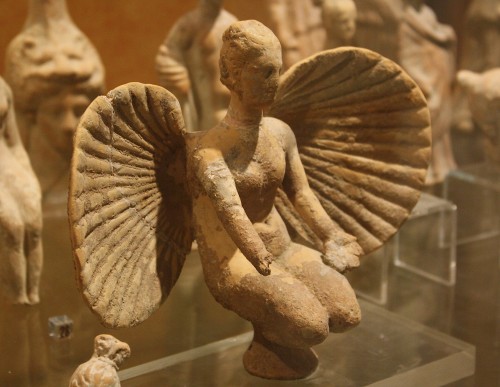
Terracotta Aphrodite, Brundisium
ARTEFACTS
While little remains of the ancient buildings of Brundisium, the city, and especially its harbour, has provided some outstanding examples of Greek and Roman art for posterity. Amongst these survivors are many bronze statues. Unfortunately, most are incomplete but some of them remain sufficiently intact to still instil awe at the skills of ancient metalworkers. A notable piece is the head and torso of a figure known as the Hellenistic Prince which dates to the 2nd or 1st century BCE. Another fine head has been identified as a Greek philosopher, possibly Antisthenes, and dates to the 4th century BCE. Besides many examples of trozella already mentioned, the town's archaeological museum possesses a fine collection of Greek pottery and terracotta figurines including a charming depiction of a crouched Aphrodite emerging from her shell.
LICENSE:
Article based on information obtained from these sources:with permission from the Website Ancient History Encyclopedia
Content is available under License Creative Commons: Attribution-NonCommercial-ShareAlike 3.0 Unported. CC-BY-NC-SA License